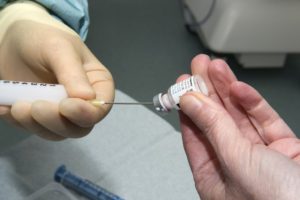Original article by By Sheila Kaplan, July 31, 2018
WASHINGTON — An injectable drug that the manufacturer says is too dangerous to use along the spine is growing in popularity for back pain as doctors turn away from opioids.
The anti-inflammatory drug, called Depo-Medrol and made by Pfizer, is approved for injection into muscles and joints. Once a drug is approved, however, doctors may legally prescribe it however they see fit. And doctors have long given Depo-Medrol shots, or the generic equivalent, close to the spinal cord for painful backs, necks and conditions like spinal stenosis.

A doctor preparing a Depo-Medrol shot to treat chronic back pain.
What few doctors or patients know is that Pfizer, faced with hundreds of complaints about injuries and complications related to the shots, asked the Food and Drug Administration to ban that type of treatment five years ago. The company cited the risk of blindness, stroke, paralysis and death — a request that neither the agency nor Pfizer made public.
The F.D.A. declined to issue a ban but toughened the label warning. Other countries — among them Australia, Brazil, Canada, France, Italy, New Zealand and Switzerland — heeded Pfizer’s request.
After concerns were raised about the off-label treatments, use of the injections declined. But the opioid epidemic appears to be spurring their popularity despite risks known to public health officials and doctors.
According to the F.D.A., back problems are the most common cause of disabling, chronic pain. Weekend classes to train physicians in the procedure are flourishing. Critics like Dr. Terri A. Lewis, a rehabilitation specialist and lecturer at the Southern Illinois University, say they are responsible for transforming pain clinics into “drill mills.”
And in June, as part of legislation to tackle the opioid crisis, the House of Representatives approved an increase in Medicare reimbursement for the procedure.
The number of Medicare providers giving steroid injections along the spine, including Depo-Medrol and other drugs, had increased 13 percent in 2016 from 2012. The number of Medicare beneficiaries receiving these injections is up 7.5 percent. The Department of Veterans Affairs reported a 17 percent increase in the injections from 2015 to 2017.
And total sales of brand name and generic Depo-Medrol grew 35 percent to $185 million from $133 million from 2015 to 2017, according to the IQVIA Institute for Human Data Science, a health data firm.
It’s a troubling trend to researchers and experts like Dr. Andrew Kolodny, co-director of opioid policy research at Brandeis University.
“The victims of our era of aggressive opioid prescribing are being exploited in some cases by interventional pain doctors, who will continue them on opioids in exchange for allowing them to perform expensive procedures that they don’t need,” said Dr. Kolodny, who is also executive director of Physicians for Responsible Opioid Prescribing. “These are not benign procedures. Patients can be harmed and are harmed.”
Pfizer, in 2013, quietly asked the F.D.A. and regulators in other countries to ban Depo-Medrol for epidural use. “It must not be used by the intrathecal, epidural, intravenous or any other unspecified routes,” the company wrote.
It is unusual for a drug company to request a contraindication for one of its own products. In this case, some doctors say Pfizer was worried about liability from the off-label use, which does not give a manufacturer the same degree of protection as approved uses.
When the F.D.A. authorized a stronger warning in 2014, it noted that giving steroid shots close to the spine could cause rare but catastrophic injuries or death. The warning applied to the entire class of epidural steroid injections, estimated at about nine million a year — and not to be confused with the pain blocks, often called epidurals, given to women during childbirth.
Now, interviews with dozens of pain specialists show that pressure to wean patients off opioids is prompting many doctors to refer patients to pain intervention specialists who promote the shots. The cost per shot varies widely, from $100 up to $800, with an additional fee going to the hospital or clinic where it is administered.
“The truth underlying it is that doing an injection is faster and results in higher reimbursements, compared to other ways of managing the same pain,” said Dr. James P. Rathmell, chairman of anesthesiology, perioperative and pain medicine at Brigham and Women’s Hospital. It was Dr. Rathmell who first brought the issue to the F.D.A. and oversaw a panel charged with recommending guidelines on safety.
“The use of injections has increased dramatically, yet the prevalence of back pain has remained relatively unchanged,” Dr. Rathmell said.
Doctors can choose among several types of epidural steroid injections. Depo-Medrol has a major share of the market. Epidural steroid injections in the cervical (neck) area and mid-back are considered the most dangerous.
They work like this: A steroid is injected into the epidural space within the spinal canal. Most of the injuries occur if the needle misses its target and directly injures nerves or places the drug into the spinal fluid or arteries, depriving the spinal cord of blood.
A review of F.D.A. records show that there were 2,442 serious problems reported from Depo-Medrol injections from 2004 through March 2018, including reports of 154 deaths. Pfizer declined to comment on the deaths, pointing to the product’s warning label: “Serious neurologic events, some resulting in death, have been reported with epidural injection of corticosteroids. Specific events reported include, but are not limited to, spinal cord infarction, paraplegia, quadriplegia, cortical blindness, and stroke.”
In West Virginia, the heart of the opioid epidemic, anesthesiologist Dr. Brian Yee said more general practice physicians are referring patients to his clinic for epidural steroid injections and other procedures, like spinal cord stimulation, than in past years.
Dr. Yee believes spinal injections are valuable if administered properly. But he worries that weekend classes aren’t sufficient training.
“With people trying to take away opioids now, we are opening up another doorway for people to overutilize other options that can be helpful with the right doctors and the right patients,” he said.

Sherry Brandt said she was told she would be prescribed opioid painkillers for her chronic back pain only if she agreed to an epidural steroid injection.
Carrie Flaten thinks she was one of the wrong patients. A self-described Montana cowgirl, Ms. Flaten badly injured her back and shoulder in a car accident at age 28 in 2007. Months later, she was still in terrible pain and began physical therapy, along with a series of epidural steroid injections.
At first the shots made her feel better. But the relief never lasted, and she ended up having so many Depo-Medrol and other injections over the years that a nurse started calling her “our pincushion.”
Her last shot, in late 2015, left Ms. Flaten in what she described as frequent excruciating pain, with difficulty walking, little bladder control and loss of sexual function. Ms. Flaten said she could not return to her job as a mechanic, and still has trouble keeping up with her children.
Ms. Flaten said her clinic has refused to give her any painkillers unless she resumes the injections — something she does not want to do. Had someone told her that Pfizer sought a ban on using the shots this way, “I would have said absolutely no,” Ms. Flaten said.
Sherry Brandt did say no, and claims that refusal led her pain clinic to dismiss her as a noncompliant patient. The 56-year-old Tennessee resident had suffered back pain for years, and received several epidural steroid injections that did not seem to harm her. But she said they did not help, either.
Physical therapy and opioid painkillers left her stable, but she still had difficulty standing or walking — which worsened after a back surgery several years ago. She said she became more reliant on painkillers until her doctor, nervous about continuing to prescribe them in the current climate, referred her to a local pain specialist. The clinic staff suggested more shots, but by then Ms. Brandt had discovered their risks and declined.
Then she got hit by a truck.
Ms. Brandt went to another pain clinic, where doctors also told her they would only prescribe painkillers if she agreed to an epidural steroid injection, she said. Again she declined, fearing it could worsen her condition. “It’s blackmail,” she said.
The clinics that Ms. Flaten and Ms. Brandt visited declined to comment.
Dennis J. Capolongo often fields calls from people like those patients. The former photojournalist became a patient advocate after epidural Depo-Medrol injections for hip pain in 2001 inflamed his nerves, leaving him bedridden for nearly three years.
Mr. Capolongo, who lives in Potomac, Md., said he still suffers from debilitating central nervous system disorders. He has been campaigning for years for the F.D.A. to ban Depo-Medrol for spinal use.
Pfizer said it cannot track how much Depo-Medrol is used for off-label shots. Company spokesman Thomas Biegi said without an F.D.A. ban, there was nothing Pfizer could do to stop the off-label shots.
“We believe this is a question of medical practice and defer to clinicians and pain experts who utilize these medicines in their practices for the treatment of pain conditions,” Mr. Biegi said.
Dr. Laxmaiah Manchikanti thinks that’s as it should be. Chief executive of the American Society of Interventional Pain Physicians, Dr. Manchikanti does not use Depo-Medrol in his own practice but believes it is safe for the lower spinal area.
In May, after the physicians’ group met with lawmakers on Capitol Hill, Representative John Shimkus, Republican of Illinois, proposed raising Medicare reimbursement rates for epidural steroid injections and other interventional procedures.
The doctors’ political action committee had donated $20,000 to Representative Shimkus’s 2016 and 2018 campaigns, according to the Center for Responsive Politics, which tracks political contributions. Democratic co-sponsor Raja Krishnamoorthi, of Illinois, also received a $10,000 donation during this election cycle, and $5,000 during his 2016 race.
The House approved the plan in June, which would reverse previous cuts of 16 to 25 percent. The Senate may consider whether to include a similar plan in its version of the opioid legislation.
Dr. James Patrick Murphy, an anesthesiologist and addiction specialist in Kentucky, believes that recent studies showing the shots do not work better than physical therapy for many patients are reason enough not to use them on so many patients. He also thinks they cost too much.
“The physician fee is usually somewhere between $100 and $300,” Dr. Murphy said, “but the hospital fee for the procedure, the separate fee, can be anywhere from $1,000 to $5,000. That’s a lot of expense for somebody when you really can’t promise you’re going to cure them.”



